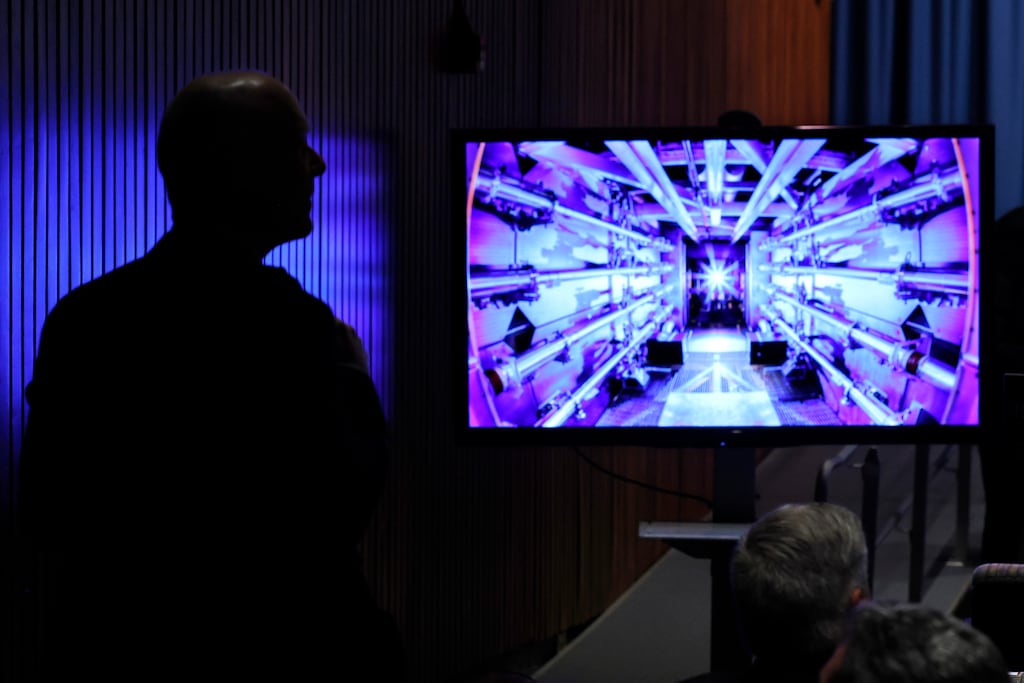Physicists are a-buzz over new results from nuclear fusion experiments in the US. But what have they found, and how big a breakthrough is it?
What is nuclear fusion?
We experience nuclear fusion every day – it is the process that gives rise to the heat and light of the sun and other stars. In brief, it involves light atoms being smashed together to produce heavier ones, releasing vast amounts of energy in the process.
To do this ourselves takes some serious engineering. At the National Ignition Facility (NIF) at Lawrence Livermore National Laboratory in California, a weak laser beam is split and the energy amplified to give 192 laser beams. These are used to heat the walls of a small gold can, called a hohlraum, to more than 3 million degrees Celsius, resulting in the emission of X-rays.
These X-rays heat a millimetre-sized capsule within the hohlraum that contains two forms of hydrogen: deuterium and tritium. The heat causes the surface of the capsule to explode outwards, forcing its contents to implode – in other words, the deuterium and tritium are forced together rapidly at very high pressure and temperature.
READ MORE
The upshot is that, in the hottest part of the fuel, fusion occurs, resulting in the formation of helium nuclei. As one helium nucleus has slightly less mass than the combination of one deuterium and one tritium nucleus, the difference in mass is released as a burst of energy. In the right conditions the helium nuclei produced in this process can transfer their kinetic energy to the remaining fuel, heating it up and triggering yet more fusion.
Should this happen, it becomes possible to release more energy than was put into the experiment by the lasers, a condition known as ignition.
[ Fusion energy: US scientists announce ‘major scientific breakthrough’Opens in new window ]
What just happened?
Researchers at the NIF have announced that, for the first time, they have managed to do just that. The team used 2.1MJ of energy to heat the fuel with lasers, releasing 2.5MJ of energy.
Is that a lot of energy?
No, not really. The difference – 0.4MJ – is about 0.1kWh. That’s about enough energy to boil a kettle to make a few cups of tea.
Why is everyone so excited?
Nuclear fusion research has been going on for 70 years and this is the first time scientists have managed to demonstrate ignition – a positive energy gain. The results show that it is indeed possible to use laser fusion to generate energy – a crucial proof of principle that will spur on research to develop the technology. That matters because it is hoped nuclear fusion will eventually provide a near-limitless, safe and clean source of energy.
How far away are we from powering our homes via nuclear fusion?
Miles. And miles. Only a small amount of excess energy was generated in the latest experiments – and it took a lot of energy, around 500MJ, to power the lasers in the first place. Such reactions would also need to happen at a much greater frequency – about 10 times a second – and be far cheaper to run before nuclear fusion could actually be used to power even a kettle.
Jeremy Chittenden, a professor of plasma physics at Imperial College London, told the Guardian: “Anyone working in fusion would be quick to point out that there is still a long way to go from demonstrating energy gain to getting to wall-plug efficiency where the energy coming from a fusion reactor exceeds its electrical energy input required to run the reactor.
“The experiments on NIF demonstrate the scientific process of ignition and how this leads to high fusion energy gain, but to turn this into a power station we need to develop simpler methods to reach these conditions, which will need to be more efficient and above all cheaper in order for inertial fusion to be realised as a fusion power source.” — Guardian










